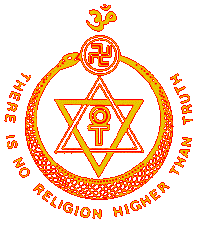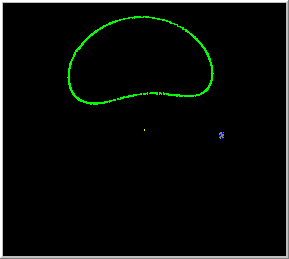Feelgood Theosophy
Welcome to the Feelgood
Lodge

Cruithne
Do we really have a second moon?
Cruithne also known as Asteroid number 3753 is an asteroid in orbit around
the Sun. Due to its unusual orbit relative to that of the Earth, it is a
periodic inclusion planetoid. It is sometimes called "Earth's second
moon", although it is not a satellite of the Earth.
Cruithne was discovered on
The asteroid is named after the Cruithne
people (also known as the Priteni or the Picts) who inhabited
Cruithne is approximately 5 km in diameter,
and its closest approach to Earth is approximately 30 times the separation
between Earth and the Moon (12 Gm or million kilometres).
Although Cruithne's orbit is not thought to be stable
over the long term, calculations by Wiegert and Innanen showed that it has likely been in sync with Earth's
orbit for a long time. There is no danger of a collision with Earth for
millions of years, if ever. Cruithne, having a
maximum opposition magnitude of +15.8, is fainter than Pluto and would require
at least a 12.5 inch reflecting telescope to attempt to be seen.
Cruithne is in a normal elliptic orbit around the Sun. However, because its
period of revolution around the Sun is almost exactly equal to that of the
Earth, they appear to "follow" each other in their paths around the
Sun. This is why Cruithne is sometimes called
"Earth's second moon".Cruithne's distance
from the Sun and orbital speed vary a lot more than the Earth's, so from our
point of view Cruithne actually follows a kidney
bean-shaped horseshoe orbit ahead of the Earth, taking slightly less than one
year to complete a circuit of the "bean". Because it takes slightly
less than a year, the Earth "falls behind" the bean a little more
each year, and so from our point of view, the circuit is not quite closed, but
rather like a spiral loop that moves slowly away from the Earth.
After many years, the Earth has fallen behind far enough that Cruithne is now actually "catching up" on the
Earth from "behind". When it eventually does catch up, Cruithne will make a series of annual close approaches to
the Earth, and gravitationally exchange orbital energy with Earth; this will
alter Cruithne's orbit by a little over half a
million kilometres (whilst Earth's orbit is altered
by about 1.3 centimetres) so that its period of
revolution around the Sun is now slightly more than a year. The kidney bean now
starts to migrate away from the Earth again in the opposite direction — instead
of the Earth "falling behind" the bean, the Earth is now
"pulling away from" the bean. The next such series of close
approaches will be centred around
the year 2292 — in July of that year, Cruithne will
approach Earth to about 12.5 million km.
After 380 to 390 years or so, the kidney-bean-shaped orbit
approaches Earth again from the other side, and the Earth, once more, alters
the orbit of Cruithne so that its period of
revolution around the Sun is again slightly less than a year (this last
happened with a series of close approaches centred on
1902, and will next happen with a series centered on 2676). The pattern then
repeats itself.
A graphic of
Cruithne’s orbit

Cruithne has a very interesting orbit which is heavily influenced by Earth.
The simulation shows Cruithne in a
rotating frame. Watch as it orbits the Sun in a kidney bean shape orbit. The
Earth has a noticable effect on Cruithne's
orbit, sometimes repelling it as it gets too close. Cruithne's
kidney bean-shaped "orbit" then spends centuries travelling all the
way around the Sun, just to meet the Earth from the other side. Earth once
again repels the kidney bean-shaped orbit. Cruithne's
kidney-bean orbit repeats this process over and over again.
Feelgood Theosophy
Thankyou for visiting the Feelgood Lodge
______________________
An
independent Theosophical Republic
Worldwide
links to FREE online
Courses,
Writings, Commentaries,